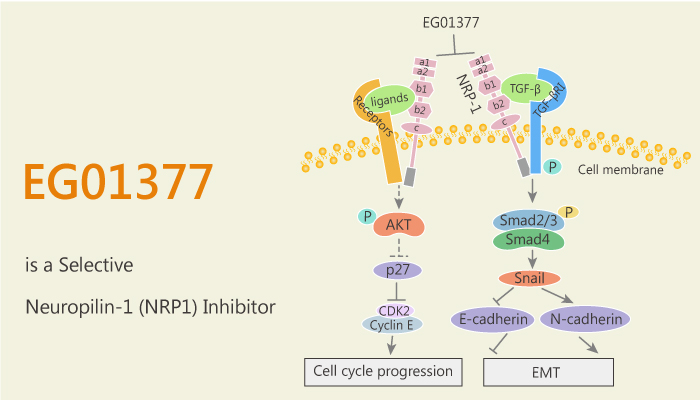Neuropilin-1 (NRP1) is a membrane-bound co-receptor of the tyrosine kinase receptor, which can be used for vascular endothelial growth factor and signal protein family members. Specifically, NRP1 plays a variety of roles in angiogenesis, axon guidance, cell survival, migration, and invasion. Specifically, the progression of NRP1 is relevant to cancer angiogenesis. In prostate cancer, NRP1 is up-regulated in the adaptive response of prostate cancer to androgen targeted therapy. Moreover, NRP1 has become a prognostic biomarker for clinical metastasis and fatal PCA. NRP1 enhances the function and survival of regulatory T cells (Tregs). Moreover, NRP1 is also important in the control of M2 metastasis of tumor-associated macrophages/microglia in gliomas. NRP1 is becoming an attractive anticancer target. EG01377 is a potent, bioavailable, and selective inhibitor of neuropilin-1 (NRP1).

EG01377 is a potent, bioavailable, and selective inhibitor of NRP1.
But, how does EG01377 protect against cancer cells via NRP1? Let’s discuss it in detail. First of all, EG01377 is a selective inhibitor of NRP1, with a Kd of 1.32 μM, and IC50s of both 609 nM for NRP1-a1 and NRP1-b1. Moreover, EG01377 has antiangiogenic, anti-migratory, and antitumor effects.
In the second place, EG01377 with 3-30 μM of 30 minutes inhibits vascular endothelial growth factor A (VEGF-A) stimulated tyrosine phosphorylation of VEGF-R2/KDR. Nonetheless, EG01377 is able to significantly reduce HUVEC cell migration in response to VEGFA. Importantly, EG01377 can delay the VEGF-induced wound closure and reduces network area, length, and branching points. Particularly, EG01377 blocks the production of TGFβ by Nrp1+ regulatory T-cell SMAD3/AKT (Tregs) in the presence of tumor cell-derived factors.
Last but not the least, EG01377 with 2 mg/kg of i.v. exhibits an encouraging half-life of 4.29 h, sufficient to sustain once per day dosing in mice.
All in all, EG01377 is a potent, bioavailable, and selective inhibitor of NRP1.
References:
Powell J, et al. J Med Chem. 2018 May 10;61(9):4135-4154.